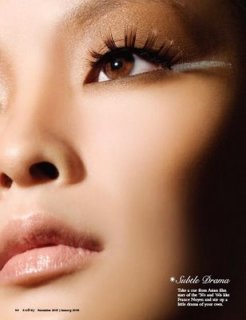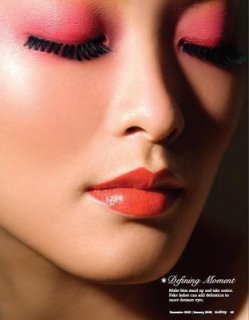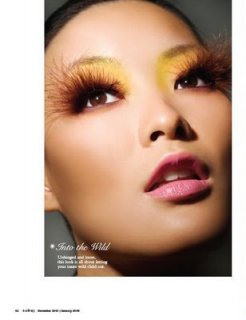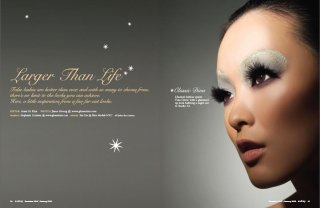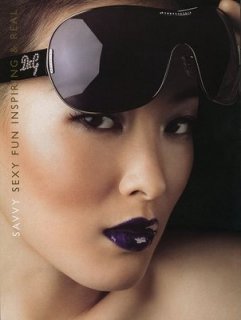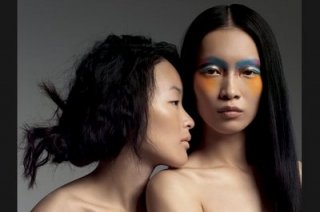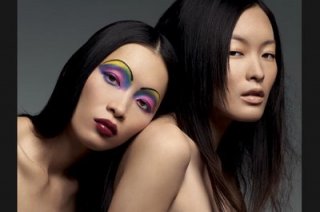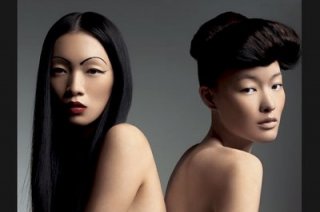The Chinese modeling market for advertising admires western looks especially catalogues. They employ second tier brazilian, american, eastern european models to do print work, but obviously with so many tall chinese girls it's the largest market for Asian models.
You are using an out of date browser. It may not display this or other websites correctly.
You should upgrade or use an alternative browser.
You should upgrade or use an alternative browser.
Chinese Models - Full List on Page #1
- Thread starter sethii
- Start date
http://www.youtube.com/watch?v=XKDIDtKTt4o
The Chinese models are amazing tall at this model award show. The girl who won has the very Asian round face very long hair with bangs.
The Chinese models are amazing tall at this model award show. The girl who won has the very Asian round face very long hair with bangs.
Fontenrose
Active Member
- Joined
- Jan 26, 2008
- Messages
- 1,483
- Reaction score
- 3
beautiful!
Pitta Patta
Member
- Joined
- May 15, 2008
- Messages
- 96
- Reaction score
- 0
love that video
thanks for introducing chinese girls .. ive never seen them before
thanks for introducing chinese girls .. ive never seen them before
One of my favorite videos, Basso Brooke Shanghai fashion show, the models have sooo much attitude.
http://www.youtube.com/watch?v=OGJiqX_mRTE
http://www.youtube.com/watch?v=OGJiqX_mRTE
One of my favorite videos, Basso Brooke Shanghai fashion show, the models have sooo much attitude.
http://www.youtube.com/watch?v=OGJiqX_mRTE
soooo fierce. reminds me of the 90's when models had to know how to walk to be in the best shows.
Model Duo Liu she represented China for Miss World 2006. Nice body, shaking her stuff down the catwalk.
http://youtube.com/watch?v=GC5JEiAfUI8&feature=related
http://youtube.com/watch?v=qTBRNH3YlHc&feature=related
http://youtube.com/watch?v=GC5JEiAfUI8&feature=related
http://youtube.com/watch?v=qTBRNH3YlHc&feature=related
Last edited by a moderator:
Tokyo vs. Shanghai: A style standoff
credit: IHT.COM

By Kaori Shoji
Published: WEDNESDAY, FEBRUARY 22, 2006

SHANGHAI: At the fashionable 1920 Café in central Shanghai, young women decked out in Dolce & Gabbana converse over elegant cups of jasmine tea while at the next table a group of men in impeccable black turtlenecks ogle them from behind horn-rimmed glasses.
The atmosphere is hip and subdued with just a whiff of sleaze - a ghostly remnant, perhaps, of the days (around 1920) when the city was popularly dubbed "wh*re of East Asia" and "Pearl of the Orient."
The big difference: Back then, the average Shanghainese wouldn't have been able to frequent a café like this one, where a cup of coffee is $2.50.This place would have been a hangout for colonialists and Western merchants. Now it's where Shanghainese models and their boyfriends come for a quiet talk before joining their friends for dinner. It's where designers show work samples to prospective clients before heading off to, say, the famed V.I.P.nightclub financed by the pop diva Faye Wong.
There's no doubt about it, Shanghai is nowthe most exciting city in East Asia, usurping Tokyo's position as No. 1. Says Kenta Mitsui, a 29-year-old photographer who moved from Tokyo two years ago: "I stand on a street corner back home and, well, it's just a street corner. In Shanghai, the streets are so vibrant, buzzing with energy, it's like the very air is reprimanding me for daring to just stand there. I should be working, going out, making tons of money, whatever, something, ANYTHING! That's the air you breathe in Shanghai."

Mitsui is one of a growing number of Japanese artists who have abandoned Tokyo and bypassed New York and Paris to put their money on Shanghai.
"In eight more years,"Mitsui predicts, "Shanghai will have outdone Tokyo in everything from fashion to music to art, and let's not even discuss architecture."
While that still remains to be seen, it's true that Tokyo's fashion and design industries can no longer afford to turn a blind eye to Shanghai's colossal influence.
Mito Yokokawa, who had worked for a Japanese apparel company and now lives in Shanghai as a media consultant-interpreter, says: "I think the Japanese woman has a lot to learn from China, particularly a city like Shanghai, where the women are attractive, strong-minded and bursting with confidence. Before, Tokyo fashion had been a lot about blending influences from the catwalks of Paris and Milan into generic brands, but I have a feeling that will change."
Indeed, Japanese fashion magazines now routinely carry articles about Shanghainese methods of makeup and style while exhorting the nation's women to adopt Chinese traditional tips on beauty maintenance. (Apparently, it's the tea. Tea, tea, tea!)
Yokokawa says she never ceases to be amazed by the perfect skin textures andthe well-defined, statuesque physiques of Shanghai women as opposed to Japanese women, whose physiques tend to be flat and uninteresting. "And Chinese women are more energetic, vibrant, strident. As a Japanese living in this city, I'm always kept on my toes."
The Japanese textile manufacturer Itokinfeels the same way. While there's nothing new about a Japanese apparel company setting up in China, Itokin has taken the formula a step further to create its very own, Chinese- Japanese brand called Sujet. Scheduled to be started this month, Sujet is helmed by the Shanghainese designer Jonii Ma and Yuma Koshino, scion ofthe Koshino family - of the London- based designer Hiroko Koshino. It aims to create a clothing line that would match the tastes of urban, professional women in both Shanghai and Tokyo.
Ma, who speaks flawless Japanese and has been working in Tokyo for the past 10 years, says the time is ripe for just this sort of brand to hit the two cities.
"Asian fashion has always been about looking young, cute and desirable well into one's 30s," she said. "I think we're a little tired of that. Sujet targets working women in the crucial years between 28 and 38, when they're super- busy trying to balance work, family, marriage, childbearing ... and still continue to look and feel beautiful! I hope this brand will allow these women to feel pampered and privileged and, at the same time, empowered."
In the meantime, Itokin will have totaled its number of outlets across China to 350 during the year.
Ma, who herself is the epitome of East Asian chic (she favors her own creations combined with Viktor & Rolf), flew to Shanghai from Tokyo, with a staff comprising some of Japan's most prominent advertising talents. They were to decide on a model to represent Sujet, and an audition that promised the winner 450,000 yuan, or about $56,000, was held in the Shanghai Itokin building. The prize went to a local model called Jin Jin, who at 23 already owned two condos and looked upon modeling as a business venture.
(Page 2 of 2)
"We're happy with the result," said Hideki Nakashima, the art directorwho was hired by Itokin to create Sujet's publicity stills. "Both the brand and Jin Jin speak of East Asia in the 21st century in a way that's beyond the prowess of the purely Japanese version. Frankly, I think we should see more of this sort of integration-collaboration going on."
Nakashima professed himself dazzled by the leaps-and-bounds progress of Shanghai, the general feeling of anything goes. "In Tokyo, the creator is hampered by red tape, laws written and unwritten, plus rigid codes of behavior. One doesn't feel that here."
The Shanghai architect Teng Kun Yen says, however, that the city still lags far behind Tokyo in terms of aesthetic design standards. Originally from Taiwan, he laments the fact that the Shanghainese are so willing to cut off all ties to history and tradition in the mad pursuit of wealth and ever larger commercial opportunities: "In such an environment ... true design cannot be nurtured."
Teng is a Japanese design fan. He bought his entire wardrobe from Issey Miyake and designed his staff's uniforms with concepts borrowed from Miyake's Pleats Please line. He is in the midst of converting a district of derelict factory sites into a space consisting of gallery, hotel, café, restaurant and boutiques that are at most, three stories high, with intricately precise details that he sees as a quintessential factor in Japanese design.
"Maybe Tokyo wants to learn from Shanghai ... but I think the feeling is mutual," he says. "Right now, there are signs that a creative dialogue is about to flourish between the two cities.
"And really, that's the most important thing, isn't it?"
credit: IHT.COM

By Kaori Shoji
Published: WEDNESDAY, FEBRUARY 22, 2006

SHANGHAI: At the fashionable 1920 Café in central Shanghai, young women decked out in Dolce & Gabbana converse over elegant cups of jasmine tea while at the next table a group of men in impeccable black turtlenecks ogle them from behind horn-rimmed glasses.
The atmosphere is hip and subdued with just a whiff of sleaze - a ghostly remnant, perhaps, of the days (around 1920) when the city was popularly dubbed "wh*re of East Asia" and "Pearl of the Orient."
The big difference: Back then, the average Shanghainese wouldn't have been able to frequent a café like this one, where a cup of coffee is $2.50.This place would have been a hangout for colonialists and Western merchants. Now it's where Shanghainese models and their boyfriends come for a quiet talk before joining their friends for dinner. It's where designers show work samples to prospective clients before heading off to, say, the famed V.I.P.nightclub financed by the pop diva Faye Wong.
There's no doubt about it, Shanghai is nowthe most exciting city in East Asia, usurping Tokyo's position as No. 1. Says Kenta Mitsui, a 29-year-old photographer who moved from Tokyo two years ago: "I stand on a street corner back home and, well, it's just a street corner. In Shanghai, the streets are so vibrant, buzzing with energy, it's like the very air is reprimanding me for daring to just stand there. I should be working, going out, making tons of money, whatever, something, ANYTHING! That's the air you breathe in Shanghai."
Mitsui is one of a growing number of Japanese artists who have abandoned Tokyo and bypassed New York and Paris to put their money on Shanghai.
"In eight more years,"Mitsui predicts, "Shanghai will have outdone Tokyo in everything from fashion to music to art, and let's not even discuss architecture."
While that still remains to be seen, it's true that Tokyo's fashion and design industries can no longer afford to turn a blind eye to Shanghai's colossal influence.
Mito Yokokawa, who had worked for a Japanese apparel company and now lives in Shanghai as a media consultant-interpreter, says: "I think the Japanese woman has a lot to learn from China, particularly a city like Shanghai, where the women are attractive, strong-minded and bursting with confidence. Before, Tokyo fashion had been a lot about blending influences from the catwalks of Paris and Milan into generic brands, but I have a feeling that will change."
Indeed, Japanese fashion magazines now routinely carry articles about Shanghainese methods of makeup and style while exhorting the nation's women to adopt Chinese traditional tips on beauty maintenance. (Apparently, it's the tea. Tea, tea, tea!)
Yokokawa says she never ceases to be amazed by the perfect skin textures andthe well-defined, statuesque physiques of Shanghai women as opposed to Japanese women, whose physiques tend to be flat and uninteresting. "And Chinese women are more energetic, vibrant, strident. As a Japanese living in this city, I'm always kept on my toes."
The Japanese textile manufacturer Itokinfeels the same way. While there's nothing new about a Japanese apparel company setting up in China, Itokin has taken the formula a step further to create its very own, Chinese- Japanese brand called Sujet. Scheduled to be started this month, Sujet is helmed by the Shanghainese designer Jonii Ma and Yuma Koshino, scion ofthe Koshino family - of the London- based designer Hiroko Koshino. It aims to create a clothing line that would match the tastes of urban, professional women in both Shanghai and Tokyo.
Ma, who speaks flawless Japanese and has been working in Tokyo for the past 10 years, says the time is ripe for just this sort of brand to hit the two cities.
"Asian fashion has always been about looking young, cute and desirable well into one's 30s," she said. "I think we're a little tired of that. Sujet targets working women in the crucial years between 28 and 38, when they're super- busy trying to balance work, family, marriage, childbearing ... and still continue to look and feel beautiful! I hope this brand will allow these women to feel pampered and privileged and, at the same time, empowered."
In the meantime, Itokin will have totaled its number of outlets across China to 350 during the year.
Ma, who herself is the epitome of East Asian chic (she favors her own creations combined with Viktor & Rolf), flew to Shanghai from Tokyo, with a staff comprising some of Japan's most prominent advertising talents. They were to decide on a model to represent Sujet, and an audition that promised the winner 450,000 yuan, or about $56,000, was held in the Shanghai Itokin building. The prize went to a local model called Jin Jin, who at 23 already owned two condos and looked upon modeling as a business venture.
(Page 2 of 2)
"We're happy with the result," said Hideki Nakashima, the art directorwho was hired by Itokin to create Sujet's publicity stills. "Both the brand and Jin Jin speak of East Asia in the 21st century in a way that's beyond the prowess of the purely Japanese version. Frankly, I think we should see more of this sort of integration-collaboration going on."
Nakashima professed himself dazzled by the leaps-and-bounds progress of Shanghai, the general feeling of anything goes. "In Tokyo, the creator is hampered by red tape, laws written and unwritten, plus rigid codes of behavior. One doesn't feel that here."
The Shanghai architect Teng Kun Yen says, however, that the city still lags far behind Tokyo in terms of aesthetic design standards. Originally from Taiwan, he laments the fact that the Shanghainese are so willing to cut off all ties to history and tradition in the mad pursuit of wealth and ever larger commercial opportunities: "In such an environment ... true design cannot be nurtured."
Teng is a Japanese design fan. He bought his entire wardrobe from Issey Miyake and designed his staff's uniforms with concepts borrowed from Miyake's Pleats Please line. He is in the midst of converting a district of derelict factory sites into a space consisting of gallery, hotel, café, restaurant and boutiques that are at most, three stories high, with intricately precise details that he sees as a quintessential factor in Japanese design.
"Maybe Tokyo wants to learn from Shanghai ... but I think the feeling is mutual," he says. "Right now, there are signs that a creative dialogue is about to flourish between the two cities.
"And really, that's the most important thing, isn't it?"
Last edited by a moderator:
Roseline Luo
credit: http://roselineluo.net/
This Shanghai born beauty is bodacious she's six feet tall and built. She's a top model in Shanghai and is finishing her college degree. It's funny that Chinese models in China are pursuing their college degrees when models in other countries drop out of high school. It says a lot about the importance of education in Chinese culture.
credit: http://roselineluo.net/
This Shanghai born beauty is bodacious she's six feet tall and built. She's a top model in Shanghai and is finishing her college degree. It's funny that Chinese models in China are pursuing their college degrees when models in other countries drop out of high school. It says a lot about the importance of education in Chinese culture.
Attachments
-
 roseline001.jpg2.4 KB · Views: 161
roseline001.jpg2.4 KB · Views: 161 -
 roseline002.jpg2.6 KB · Views: 162
roseline002.jpg2.6 KB · Views: 162 -
 roseline003.jpg3 KB · Views: 164
roseline003.jpg3 KB · Views: 164 -
 roseline004.jpg2.5 KB · Views: 162
roseline004.jpg2.5 KB · Views: 162 -
 roseline005.jpg2.1 KB · Views: 160
roseline005.jpg2.1 KB · Views: 160 -
 roseline010.jpg2.4 KB · Views: 157
roseline010.jpg2.4 KB · Views: 157 -
 roseline009.jpg2.9 KB · Views: 158
roseline009.jpg2.9 KB · Views: 158 -
 roseline008.jpg2.4 KB · Views: 162
roseline008.jpg2.4 KB · Views: 162 -
 roseline007.jpg2.8 KB · Views: 159
roseline007.jpg2.8 KB · Views: 159 -
 roseline006.jpg2.4 KB · Views: 163
roseline006.jpg2.4 KB · Views: 163
Attachments
-
 roseline015.jpg3.4 KB · Views: 157
roseline015.jpg3.4 KB · Views: 157 -
 roseline014.jpg3.2 KB · Views: 159
roseline014.jpg3.2 KB · Views: 159 -
 roseline013.jpg3.4 KB · Views: 159
roseline013.jpg3.4 KB · Views: 159 -
 roseline012.jpg3 KB · Views: 162
roseline012.jpg3 KB · Views: 162 -
 roseline011.jpg3.3 KB · Views: 164
roseline011.jpg3.3 KB · Views: 164 -
 roseline016.jpg2.7 KB · Views: 161
roseline016.jpg2.7 KB · Views: 161 -
 roseline017.jpg3 KB · Views: 161
roseline017.jpg3 KB · Views: 161 -
 roseline018.jpg3.6 KB · Views: 160
roseline018.jpg3.6 KB · Views: 160 -
 roseline019.jpg2.3 KB · Views: 161
roseline019.jpg2.3 KB · Views: 161 -
 roseline020.jpg2.7 KB · Views: 157
roseline020.jpg2.7 KB · Views: 157
Attachments
-
 roseline026.jpg3.2 KB · Views: 161
roseline026.jpg3.2 KB · Views: 161 -
 roseline025.jpg2.1 KB · Views: 158
roseline025.jpg2.1 KB · Views: 158 -
 roseline023.jpg2.9 KB · Views: 158
roseline023.jpg2.9 KB · Views: 158 -
 roseline022.jpg3.6 KB · Views: 157
roseline022.jpg3.6 KB · Views: 157 -
 roseline021.jpg2.4 KB · Views: 159
roseline021.jpg2.4 KB · Views: 159 -
 roseline031.jpg2.6 KB · Views: 161
roseline031.jpg2.6 KB · Views: 161 -
 roseline030.jpg2.9 KB · Views: 162
roseline030.jpg2.9 KB · Views: 162 -
 roseline029.jpg2.5 KB · Views: 156
roseline029.jpg2.5 KB · Views: 156 -
 roseline028.jpg2.5 KB · Views: 159
roseline028.jpg2.5 KB · Views: 159 -
 roseline027.jpg2.4 KB · Views: 158
roseline027.jpg2.4 KB · Views: 158
Attachments
-
 roseline037.jpg2.5 KB · Views: 156
roseline037.jpg2.5 KB · Views: 156 -
 roseline036.jpg2.7 KB · Views: 158
roseline036.jpg2.7 KB · Views: 158 -
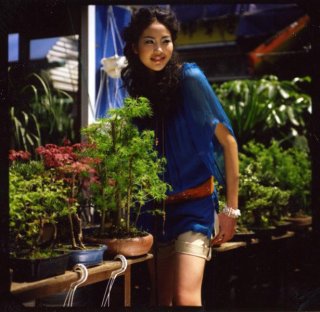 roseline035.jpg98.7 KB · Views: 1
roseline035.jpg98.7 KB · Views: 1 -
 roseline034.jpg2.7 KB · Views: 158
roseline034.jpg2.7 KB · Views: 158 -
 roseline032.jpg2.4 KB · Views: 157
roseline032.jpg2.4 KB · Views: 157 -
 roseline038.jpg3.9 KB · Views: 162
roseline038.jpg3.9 KB · Views: 162 -
 roseline039.jpg2 KB · Views: 156
roseline039.jpg2 KB · Views: 156 -
 roseline040.jpg2.9 KB · Views: 156
roseline040.jpg2.9 KB · Views: 156 -
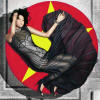 roseline041.jpg4.5 KB · Views: 159
roseline041.jpg4.5 KB · Views: 159 -
 roseline042.jpg2.4 KB · Views: 155
roseline042.jpg2.4 KB · Views: 155
Attachments
Western models can drop out of school because it's easier for them to go back later or do something else, not because they don't value education. The socio-economic system is more flexible. It's good that in the domestic market chinese models will finish their education, but it disadvantages them in the international market because they are over the hill when they begin doing shows in europe/ny.
anyway!
Liu Wen did Chanel Haute Couture today! I can't remember the last Chinese model to do that show...
anyway!
Liu Wen did Chanel Haute Couture today! I can't remember the last Chinese model to do that show...
Last edited by a moderator:
asianmodelsblog.blogspot.com
Ling Tan's sister is sharp.
Ling Tan's sister is sharp.
Attachments
Last edited by a moderator:
Similar Threads
- Replies
- 140
- Views
- 86K
- Replies
- 8
- Views
- 6K
Users who are viewing this thread
Total: 1 (members: 0, guests: 1)




 It seems Karl really likes her!
It seems Karl really likes her!
